Nivada Antarctic Models: Difference between revisions
| Line 2: | Line 2: | ||
[[File:Antarctic logo hangtag.jpg|thumb]] | [[File:Antarctic logo hangtag.jpg|thumb]] | ||
Authosr: [[User:Richard|Richard Phillips]] and others | |||
For the history of these models read [[Nivada Antarctic|here]]. The Nivada Antarctics are a fascinating subject for collectors. With a seemingly never-ending variety since 1956, there is something for everyone. Please note that for the purposes of simplicity, Croton, Nivada and other permutations of CNG are assumed to be all interchangeable on the dial, rotor, crown, box etc. By definition given Croton was the US distributor of Nivada, more Croton examples will be seen in North America, and likewise Nivada Grenchen will predominate in Europe. | For the history of these models read [[Nivada Antarctic|here]]. The Nivada Antarctics are a fascinating subject for collectors. With a seemingly never-ending variety since 1956, there is something for everyone. Please note that for the purposes of simplicity, Croton, Nivada and other permutations of CNG are assumed to be all interchangeable on the dial, rotor, crown, box etc. By definition given Croton was the US distributor of Nivada, more Croton examples will be seen in North America, and likewise Nivada Grenchen will predominate in Europe. | ||
Revision as of 14:47, 3 April 2024
Nivada Antarctic Watches - an introduction
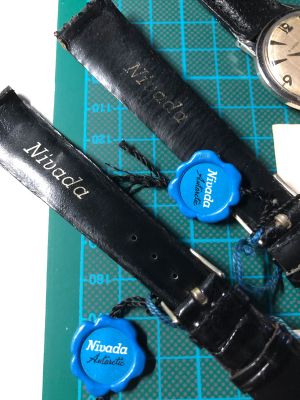
Authosr: Richard Phillips and others
For the history of these models read here. The Nivada Antarctics are a fascinating subject for collectors. With a seemingly never-ending variety since 1956, there is something for everyone. Please note that for the purposes of simplicity, Croton, Nivada and other permutations of CNG are assumed to be all interchangeable on the dial, rotor, crown, box etc. By definition given Croton was the US distributor of Nivada, more Croton examples will be seen in North America, and likewise Nivada Grenchen will predominate in Europe.
There are additional links at the top of each section which will go to further pages for reading and examples on specific model ranges within the huge Antarctic continent of watches.

Nivada Antarctic Early Models
The very first models, including the watches used during ODF I, did not bear the Antarctic name. Otherwise identical to the slightly later Antarctic-labeled watches, they had either sterile or “Aquamatic” dials. “Antarctic” first appeared in production on August 8, 1956 and was registered as a trademark on May 14, 1957 based on an application filed September 12, 1956—five months after the completion of ODF I. The original watch model itself appears around 1954/55. There is a great deal of cross-referencing with the Aquamatic models of the same period and the two names appear interchangeable on some models. Between 1957 and 1964 there are a wide variety of model ranges and styles using the Antarctic nomenclature, from rugged explorer watches, to divers and all the way up to dress watches and expensive certified gold chronometers. As described here, Nivada and Croton used the marketing kudos of association with ODF I to the fullest, and it even continues to this day with the new company offering an Antarctic in its range, alongside the famous Chronomaster.
Movements will carry the COW stamp on US imported models. This denotes a Nivada Grenchen SA movement, imported by Croton.
This cataloguing of Antarctic models finds a natural break at the start of 1964. The reason for this is the appearance of the T denoting tritium dials and/or hands is made compulsory in Switzerland after this date. It makes dating a watch slightly easier. The absence of any company history and inability to produce extracts from any archives due to the original company's demise in the 1970s makes precise dating and chronology of the range an inexact science at best. This is entirely a work in progress and as more collectors provide information we can begin to fill in the gaps and establish a fuller history of these amazing watches.
Early models are most popular with collectors having the distinctive hour markers, blued second hand, flat lugs and white sometimes textured dials, known as tundra and glacier. They capture the purity of the original concept of a rugged accurate waterproof watch able to withstand the elements.
First Series Flat Top Lug Models
AO V.1a Early Model - Sterile Dial circa 1954-57
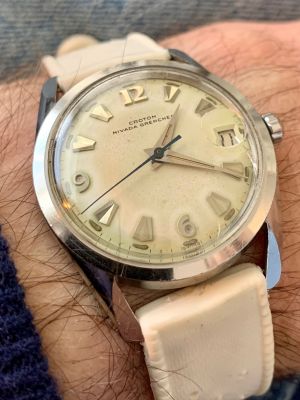
With the same flat lug case and big crown as the first series, these contain an ETA with and without date dial and no Antarctic subtext. It is assumed that these were made before the US Navy 1957 DeepFreeze tour as Nivada certainly used the marketing coup associated with the expedition to its maximum on a huge variety of dials after this date. The same watch also appears with the Antarctic name in an advert. This ETA movement is mostly associated with models circa 1950-1954. The casebacks appear with various permutations of 61 and 63 so it is assumed this is the reference and the case type and movement (eg date or no date), 63L steel etc although this may be some kind of other case coding or year dating.
- Radium dial and hands
- Domed crystal with cyclops (square or round)
- 17.5mm lug width
- ETA 1258 with signed rotor
- White dial, silver furniture, blued second hand (steel on gold-cased models)
- 34mm width ex crown
- screw dodecahedron caseback with 61 or 63L engraved (steel) 63Y (20micron rolled gold)
- Larger winding crown
AO V.1a Early Model - Tundra Dial circa 1954-61

The tundra dial is a rippled effect, unique to Nivada and not seen by this author on any other manufacturers watches. It supposedly replicated snow drifts. These are most commonly seen with Antarctic script but also, in this example, with Aquamatic script and Croton Nivada Grenchen (CNG). They share the same flat lug case and big crown as the first series, ETA and normally no date. It is assumed that these were made before the US Navy 1957 DeepFreeze tour as Nivada certainly used the marketing coup associated with the expedition to its maximum on a huge variety of dials after this date. The same watch also appears with the Antarctic name in an advert. This ETA movement is mostly associated with models circa 1950-1954. The distinctive lug shape, blue second hand and silvered numerals make these popular with collectors.
- Radium dial and handswith cyclops (square or round)
- 17.5mm lug width
- ETA 1256 with signed rotor
- White dial, silver furniture, blued second hand
- 34mm width ex crown
- screw dodecahedron caseback with 61
- Larger winding crown
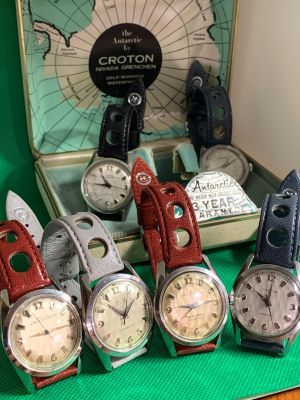
AO V.1b - Circa 1956 to 1964
The Antarctic signed dial first appears, in conjunction with the US Navy Deep Freeze expedition.
- Diameter (excluding crown): 35mm
- Lug to lug: 42mm
- Lug width: 18mm
- Large crown for ease of winding whilst wearing gloves in cold conditions
- Movement: Various automatic ETA 1256, 23xx, 24xx.
- Power reserve: ~40 hours
- Case: All stainless steel, later gold plated available.
- White dial with radium lume and steel hands with lume
- Blued second hand
- Most non-date, some date versions - see below.
- Dial lettering can contain Croton, Nivada Grenchen combinations.
AO V.1c - Circa 1963 onwards
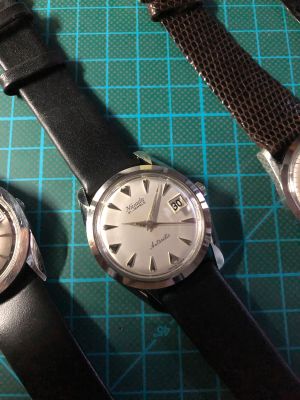
Same bevelled case but change of logo and font indicate a later model.
- SWISS MADE but no T on the dial.
- Different crown to original issue.
- Nivada only on dial and 21 Jewel count.
- Stylised Antarctic font.
- Different hour markers and no numbers.
- Gold plated version also seen with gold hands and simple baton markers
AO V.2 Antarctic D dial
It may be that the additional D stands for Date on these models.
- Circa 1960-64. No T on dial.
- A different case with straight beveled lugs and screw caseback
- Partially concealed crown
- Linen dial and slightly different hour markers. Blue second hand remains on steel version with lumed hands.
- Gold 20 micron version with linen dial. gold markers and hands - layout as per steel version.
- Crystals can have both round and square cyclops.

Straight Lug Antarctic Models
AO V.3 Antarctic Glacier Dial
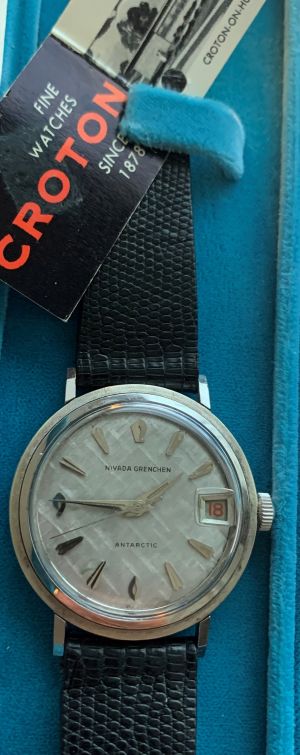
Very unusual and distinctive styling gives this rare model a unique appearance and appeal to collectors. The dial has a hatched linen appearance which is echoed with the thin outer bezel. The polished markers and hands are set off by the polished steel case ring outside the crystal. A 6 point caseback, red dial wheel with trapezoid window and very thin lugs give this example a real dress feel, one to slip on under a tuxedo. It is quite mesmeric to look at and changes colour depending on the light. Estimated manufacture period 1960-64. A rare gold capped version has also been identified.
- 34mm width ex crown
- 17.6mm lug width
- 39mm lug to lug
- small lugs with delicate faceting
- 6 point screwback case
- Domed crystal with cyclops
- Pre 1963-4 SWISS marked with no T on dial.
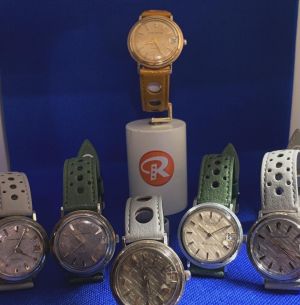


The Antarctic Roman Numeral (ARN) models
Antarctic II
MORE INFORMATION REQUIRED
Antarctic III
Additional variety was introduced by with Version 3. A move towards a more formal dress style saw thinner lugs and bezels and away from the original explorer concept. The crowns are unsigned and less substantial than the original scallop shape (which had first been seen on the original Aquamatics from the early 1950s).
Most dials have been observed with some marking- they are very prone to wear, damage and water ingress sadly. The unsmooth surface of the linen dial attracts dust and traps moisture. Pristine examples command a premium and will normally be NOS unworn. Another factor is the lacquer or varnish used on dials in this period by Nivada. It is prone to yellowing and discolouring as well as crazing, particularly if there has been any damp ingress, a distinct possibility with the non screwdown crown and a model marketed as waterproof. Very often a white dial (the Antartctic default dial colour) will appear at first glance to be cream or yellow. This can have a charm all its own - all dependent on the individual collectors eye for patina.
At some point around 1960 the font changed from a straight simple uppercase san serif to a stylised wavy written style for the word Antarctic. This is also seen in adverts at the time.
The automatic calibers are normally ETA movements with signed rotor and COW stamped on US models marketed by Croton. Casebacks will have a serial number starting A6 and then 5 digits. Range identified so far 74### to 75###.
ARNIII V1 Straight Text

- Circa 1959-1964
- Normally seen with linen dial, silver markers and lumed silver hands, radium or tritium. Models post 1963 have T on the dials.
- Diameter (excluding crown): 35mm
- Lug to lug: 42mm
- Lug width: 18mm
- Height: 10mm
- Movement: ETA 2451 and 2651 with various jewel counts including 17, 21 and 30 which may also appear on dial.
- Power reserve: ~40 hours
- Case: All stainless steel with 6 point screwback
- Straight lugs with bevel edge and drilled holes
- Plain unsigned crown
- Domed Crystal
ARNIII V2 Wavy Text
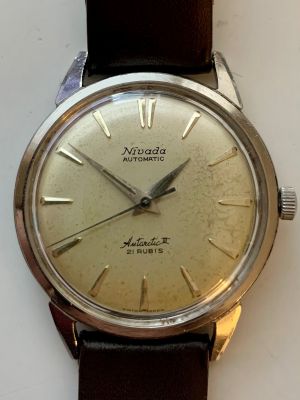
- Circa 1959-1964
- Normally seen with plain dial where the lacquer has discoloured to yellow from original white.
- Silver baton markers and lumed silver hands. Swiss Made on dial at 6.
- Diameter (excluding crown): 34.6mm
- Lug to lug: 40.6mm
- Lug width: 17.8mm
- Height: 9.6mm
- Movement: ETA 2451 21 jewel count on dial.
- Case: All stainless steel with 6 point screwback marked A6 (ref?) and Antarctic engraved
- Straight lugs with bevel edge and drilled holes
- Plain unsigned crown
- Domed Crystal
Antarctic IV
Gold plated version of the Antarctic III. Same font style, linen dial and gold markers. Crown slightly larger than the steel version in some cases depending on movement. ETA movement again with 17, 21 or 30 jewel count. Note dial does not have automatic on it but it has self-winding on screwed caseback, together with an astonishing typo with the misspelling of ANTARCTIC with ANTARTIC! 34mm x 41mm approx.
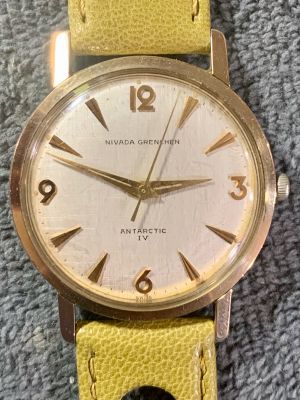
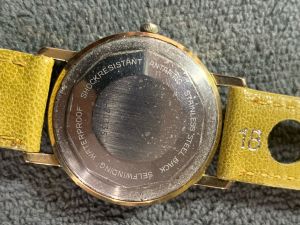
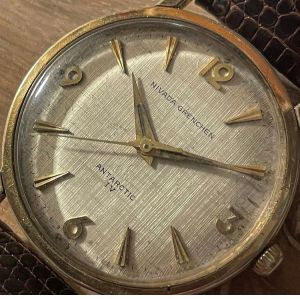
Antarctic V
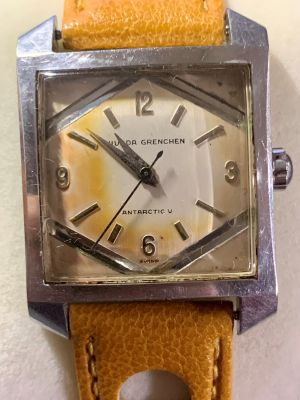
Steel version of the VI. Example has radium burn on dial. Seen here with a strap from Ralstra From Richard Phillips Collection.
Antarctic VI
Square man's dress watch in compressor style Aquadatic case with 4 screws holding gold plated outer case. A small automatic movement with scallop crown. Seen with two different dial configurations - one a segemnted two tone and the other a brushed vertical linen. The linen is in silver but a gold version also is seen. This may be a heavily tarnished or patinated version of the former.
- Automatic
- 28.4mm width ex crown
- 35mm length
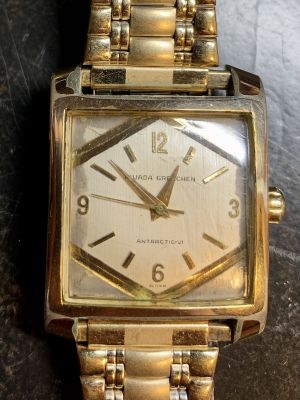
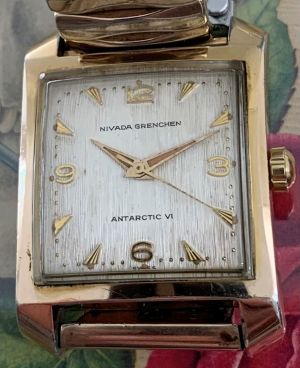

Antarctic VII
A black dial with gold case has been seen once. Clearly a rare model.
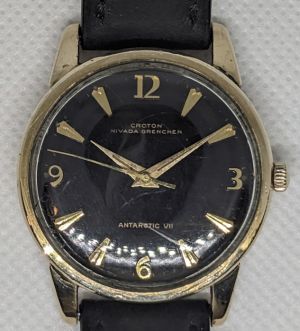
A square gold plated dress watch has also been seen with this name.
Post 1964 models
For more about the Antarctic models released after 1964 please read here - Nivada Antarctic Late Models
Nivada Antarctic Diver Models
Although the original Antarctic watches are waterproof and fairly rugged, there was clearly a marketing push to appeal to a wider audience with diving watches being a logical move away from the more formal dress nature of the 1957/57 line. An entire range of diver models are seen with the Antarctic name, including Submarino, Antarctic 200, Super Antarctic from the early 1960s onwards and the name has continued in some form or other with Quartz and lesser models. Read more about the original and collectible models here.
Nivada Antarctic Chronometre
Rare chronometer version of the standard watch - sometimes seen in solid gold Click to read here about this special model
At Chronopedia we are trying to collate the Chronometre certificate numbers for this model. Click here if you wish to add yours. Nivada_Chronometre_Serial_Numbers
Links
- Nivada Aquamatic
- Croton Nivada Grenchen - Flat Top Lug Antarctic Models 1954-64
- Nivada Antarctic Roman Numeral (ARN) models
Credits and Further Reading - https://www.vintagenivada.com/
